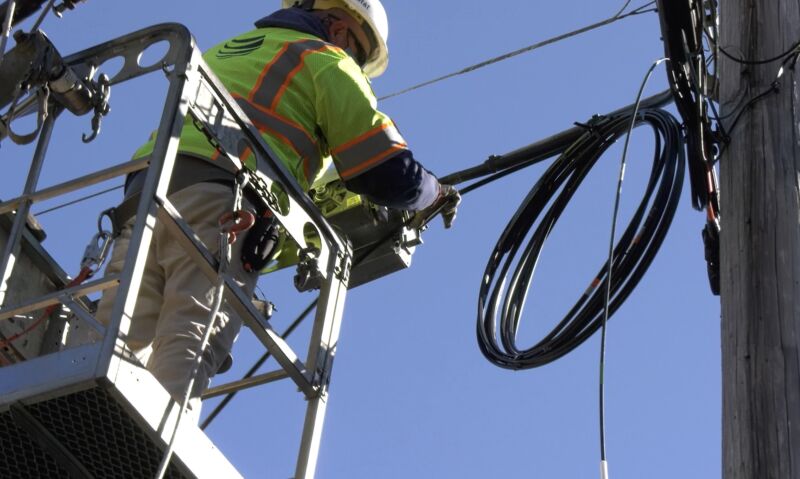
AT&T says that supply-chain shortages will delay fiber construction to about 500,000 homes that it originally planned to wire up this year and warned that shortages are likely to impact other companies that purchase fiber even more.
“Up through the second quarter, we hadn’t really experienced any impact from the supply-chain disruptions that are happening across the industry. But since the start of the third quarter, we are seeing dislocation across the board including in fiber supply,” AT&T Senior Executive VP and CFO Pascal Desroches said yesterday at a virtual conference hosted by Oppenheimer.
AT&T previously told investors to expect “3 million homes passed [with fiber] this year,” Desroches said. “We’re probably going to come in a little bit light, probably around 2.5 [million].”
The planned deployment of 3 million locations includes all the fiber construction AT&T has completed in the first seven months of 2021. As we’ve written previously, AT&T is expanding its fiber builds in about 90 metro areas, with new locations primarily consisting of homes and businesses close to AT&T’s existing fiber installations.
Global shortages roil industries
Global semiconductor shortages have been disrupting plans for much of the tech industry and automakers. The broadband industry is being hampered by the shortages in chips, other components, and fiber itself.
AT&T typically has no problem getting fiber at a low cost, Desroches said. “We’re the largest fiber purchaser in the country and we have prices that are the best and most competitive in the industry,” he said. “We feel really good about the ability to secure fiber inventory at attractive price points and the ability to execute the buildout at scale, something that many others don’t have.”
AT&T expects to catch up to its original fiber-construction estimates in the years after 2021, largely because of what Desroches called its “preferred place in the supply chain” and “committed pricing.” As AT&T said in a news release yesterday, AT&T is “working closely with the broader fiber ecosystem to address this near-term dislocation” and “is confident it will achieve the company’s target of 30 million customer locations passed by the end of 2025.”
AT&T had deployed fiber to about 15 million locations by early 2021, so the plan is to double that by 2025. There are about 53 million households in AT&T’s 21-state home-Internet service area, leaving over 20 million where AT&T has no plans to upgrade from old copper lines to fiber.
Internet providers without a preferred place in the supply chain will have more trouble getting fiber than AT&T, Desroches pointed out. “We don’t think it’s going to impact us long-term, but I think it’s really important context. If we’re feeling the pain in this, I can only imagine what others in the industry are experiencing,” he said.
While Desroches “did not name AT&T’s fiber vendor, he noted it was a US company which has both domestic and international locations. Both CommScope and Corning would fit that description,” FierceTelecom wrote. “The latter recently highlighted an uptick in orders in its optical segment, but CFO Tony Tripeny warned on Corning’s Q2 earnings call it was already facing supply chain disruptions and expected ‘glass supply to remain short to tight in the upcoming quarters.'”
Small ISPs feel pain of shortage
A trade group that represents rural ISPs described the shortages its members face in a filing with the Federal Communications Commission last month.
“NTCA members report widespread delays in obtaining communications equipment of all kinds, which extends not only to electronics (such as routers, optical network terminals, and customer premises equipment ‘CPE’) but also fiber. The delay appears to have begun soon after the onset of the COVID-19 pandemic and has escalated since then,” according to the filing by NTCA–The Rural Broadband Association.
NTCA did an informal survey of its members and found that the “minimum delay reported by members was generally three to four weeks, with some members reporting a delay of greater than 12 weeks and, in some instances, not being able to obtain the equipment for the 2021 construction season.”
AT&T loves fiber but doesn’t want everyone to get it
Desroches argued that fiber’s symmetrical speeds are becoming a necessity and said, “There is no better technology for connectivity.”
“As a result of what you’ve seen in the last year in the pandemic, the need to do what we’re doing now—two-way communication [via video conference]—can only happen with symmetrical speeds,” he said. “I think everyone has had an ah-ha moment, ‘we need to deploy fiber.’ We’ve long believed that and this is just really leaning into that opportunity.”
AT&T has repeatedly touted the superiority of fiber when talking to investors despite fighting against nationwide fiber construction. In March, AT&T told the US that it shouldn’t demand high upload speeds when giving funding to ISPs, claiming that rural people don’t need fiber and should be satisfied with Internet service that provides only 10Mbps upload speeds.
AT&T doesn’t want to face competition from fiber in places that it has deemed not profitable enough for upgrades. AT&T’s March statement said that funding faster networks in areas not served by fiber “would needlessly devalue private investment and waste broadband-directed dollars.”
Fiber a big moneymaker for AT&T
Desroches said that AT&T’s goal is to get at least 40 percent of homes subscribed to fiber in areas where AT&T deploys it. “We think in certain markets we’ll have an opportunity to do better than that,” he said.
Fiber helps AT&T boost revenue both from home-Internet subscribers and large enterprises. “It’s so critical to roll this out because the ability to grow both your enterprise and consumer business is attractive, and we think these investments will provide us with mid-teen returns over time,” he said.
Desroches also spoke briefly about AT&T’s wireless home-Internet service, saying, “There is a place for fixed wireless in certain rural communities where it’s hard to make the economics work through a fiber buildout and it may make sense to use a fixed wireless solution.”
